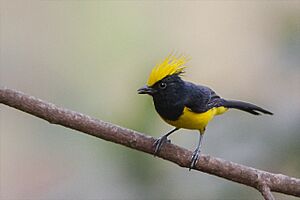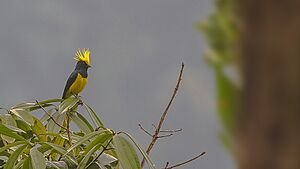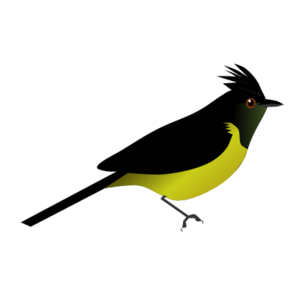Sultan tit facts for kids
Quick facts for kids Sultan tit |
|
|---|---|
 |
|
| From Mahananda Wildlife Sanctuary, India. | |
| Conservation status | |
| Scientific classification | |
| Genus: |
Melanochlora
|
| Species: |
sultanea
|
 |
|
| sultan tit distribution | |
The sultan tit (Melanochlora sultanea) is a colorful bird that lives in Asian forests. It has a bright yellow crest, a dark beak, and black feathers on its upper body. Its belly and chest are yellow. Male and female sultan tits look quite similar. However, females have greenish-black upper parts and a yellowish throat. Young birds are not as bright as adults and have a shorter crest. This bird is the only species in its group, called Melanochlora. It is different from other tit birds, but its closest relative is the Sylviparus tit.
Contents
What Does a Sultan Tit Look Like?
Male sultan tits have a brilliant yellow forehead and a crest (a tuft of feathers on their head). Their upper body, sides of the head, neck, chin, throat, and chest are deep black with a green shine. The feathers on their upper body have a metallic look. The outer tail feathers have white tips. From the chest down, their lower body is bright yellow. Their thighs have white stripes or spots. When the bird is alert or scared, it can raise its crest.
Female sultan tits have duller yellow parts. Their upper body and sides of the head are dark greenish-brown. Their chin and throat have a dark olive-green shine. Their wings and tail are dull black. The feathers on their upper body have metallic green edges.
Young sultan tits look like the females. However, when they are very young, they don't have the bright edges on their upper body feathers. Their larger wing feathers have white edges.
These birds usually look for food alone or in small groups. They mostly eat insects. Sometimes, they also eat figs. Their calls are loud and sound like short, repeated whistles. They have a slow, fluttering way of flying.
A sultan tit's beak is black, and its eyes are dark brown. Its legs are grey, and its claws are dark. These birds are about 8 inches long. Their tail is about 3.8 inches, and their wing is about 4.4 inches. They weigh between 35 and 49 grams.
Where Do Sultan Tits Live?
Sultan tits live in many parts of Asia. There are four main types, called subspecies, that are recognized:
- The sultanea type lives from central Nepal across the eastern Himalayas. You can also find it in northeastern Bangladesh, Myanmar, northern Thailand, and southern China.
- The flavocristata type lives further south in Thailand, the Malay Peninsula, and Hainan.
- The seorsa type lives in Laos and parts of southeastern China.
- The gayeti type has a black crest on both males and females. It is found in Laos and Vietnam.
In India, you can find sultan tits in the lower parts of the Himalayas. They live from Nepal to the Assam valley, the Khasi Hills, and other areas. They usually live in large trees in small groups. They do not seem to live higher than 4000 feet (about 1200 meters) above sea level.
Sultan Tit Sounds
Sultan tits are very vocal birds. They make several different sounds. Some calls sound like a rattling "chi-dip, tri-trip." They also make harsh, hissing sounds and squeaky, repeated "wheet" whistles.
Reproduction and Life Cycle
In India, sultan tits lay their eggs from April to July. A female usually lays five to seven eggs. They lay their eggs inside a tree hole that they have lined with soft materials. Sultan tits feed their young caterpillars and sometimes small berries.
Conservation Status
Sultan tits are found in many suitable habitats across their large range. Because of this, they are listed as "Least Concern" on the IUCN Red List of Threatened Species. This means they are not currently in danger of disappearing.




